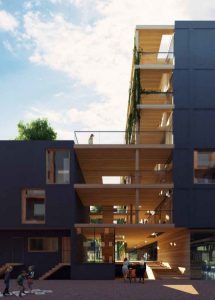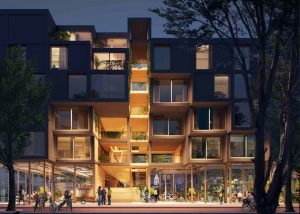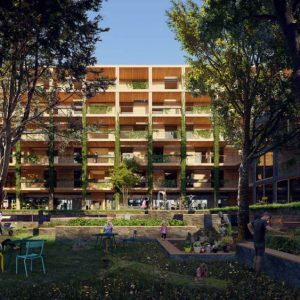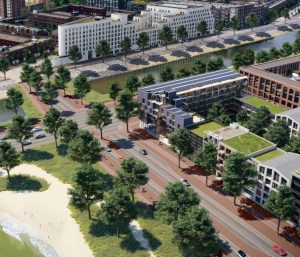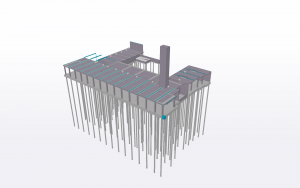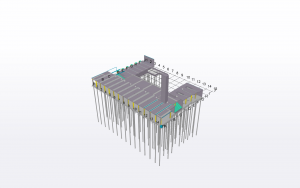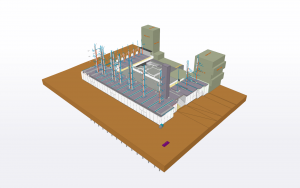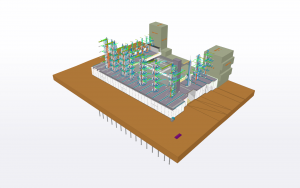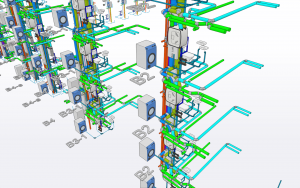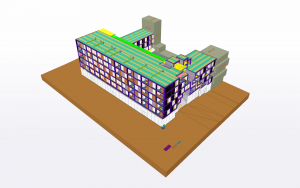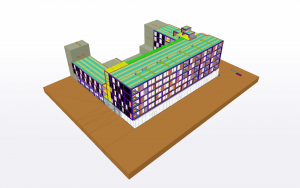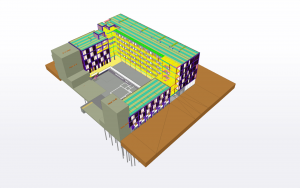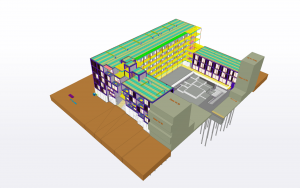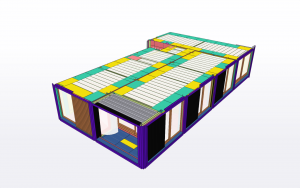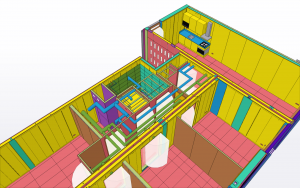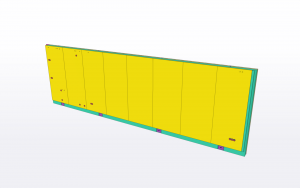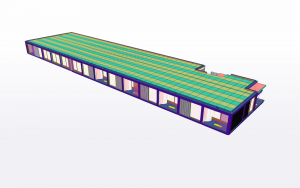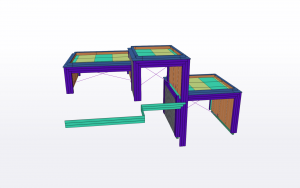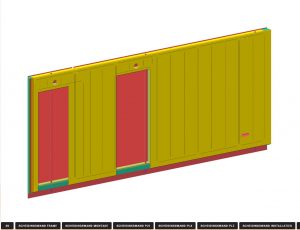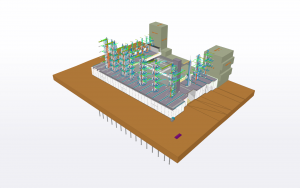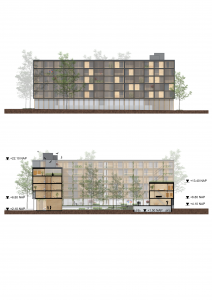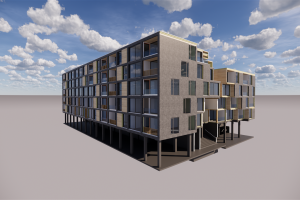Juf Nienke

| Categorie | Commerciële projecten |
|---|---|
| Jaar | 2022 |
| Land | Benelux |
| Organisatie | Barli |
| Projectpartners | RAU SeARCH, Hazenberg Bouw b.v., Goudstikker - de Vries b.v., H&R Bouwkundig ingenieursbureau, Bimdrive b.v., Coolwijk Trappenindustie b.v., Roy van Ras dakbedekkingen, Schildersbedrijf Franko van Bussel, Paul van Oort tegelwerken, Installatie en Airconditionong van der Pas, Schouten Techniek, van den Heuvel Elektrotechniek b.v., van Grinsven b.v., Red Building, Jupiter, Timmerfabriek Neede, Laminated Timber Solutions, Wijma |
| Auteur | Bart van der Kallen |
| Co-auteurs | Rutger van Grotel, Niek van Huizen, Tom Steenis, Luuk de Louw |
| Cliënt | Dokvast |
| Plaats van constructie | Uden - Amsterdam |
| Tags |
Juf Nienke is op veel vlakken een bijzonder project, niet in de laatste plaats omdat de 61 appartementen modulair en in hout gebouwd worden en deze constructieve opbouw nog nooit eerder is gedaan. Naast de bouwkundige complexiteit is het een enorme uitdaging om met veel verschillende partners in één model te werken, van architect en co-aannemer tot opdrachtgever en diverse onderaannemers. In de engineering werken partners zelf specifieke onderdelen uit (zoals de betonnen onderbouw, de kozijnen, E-, W- en Nuts, maar ook de dakdekker) én het model wordt intern in diverse delen van ons productieproces gebruikt. Zowel in de geautomatiseerde prefabricage van onze houtskeletbouw-elementen (2D) als in de assemblage (3D) in onze hallen én op de bouwlocatie in Amsterdam. Vanuit Tekla Structures sturen wij al onze machines aan: van Hundegger, platenzaag tot Mobi: een papierloos digitaal proces!
Naadloze samenwerking in Tekla
De software in Tekla heeft het mogelijk gemaakt om dit in z’n geheel te modelleren. We hebben specifieke software laten maken: een plugin om bijvoorbeeld de complexe samenstelling van de wanden met onder meer driedubbele bekleding te kunnen tekenen. Tekla bracht de knelpunten in de modellen van de verschillende partijen goed in beeld. Galerij-ankers van de leverancier moet perfect aansluiten op ons model voor de modules en opbouw. Door samenwerking in het model waren we in staat om dat naadloos op elkaar te laten aansluiten. Ook kunnen we dankzij het model een compleet materialenpaspoort samenstellen om op te nemen in Madaster (o.b.v. NLSFB-codering).
Circulaire architectuur, modulaire bouwmethode
Juf Nienke is het nieuwe entreegebouw van Centrumeiland op IJburg en na oplevering het meest duurzame woongebouw van Amsterdam. Juf Nienke bevat 61 appartementen, specifiek bedoeld voor leerkrachten en andere sleutelberoepen zoals zorg of veiligheid. Het geheel wordt opgebouwd met een slimme schakeling van geprefabriceerde houten modules (HSB en deels CLT). De woonmodules komen kant-en-klaar uit de woningfabriek van Barli en worden van Uden naar Amsterdam gereden waar ze met één hijskraan op de juiste plek gestapeld worden. De modules hebben een standaard breedte van 4m met variërende dieptes en zijn demonteerbaar waardoor het gebouw makkelijk aangepast kan worden naargelang het toekomstig gebruik.
Natuurinclusief en biobased
Juf Nienke wordt een volledig circulair, natuurinclusief en energiepositief gebouw met een stoere en stedelijke uitstraling, ontworpen door RAU en SeARCH voor Dokvast. Het heeft een 15m hoge houten hoofddraagconstructie bovenop een betonnen tafelconstructie. De voor Juf Nienke gebruikte materialen zijn voor het merendeel biobased en gerecycled; ze hebben een lage milieubelasting en zijn grotendeels hernieuwbaar. Doordat het gebouw nagenoeg volledig in hout is gebouwd, slaan we met de woningen ruim 580.000 kg CO2 op waarmee we actief bijdragen aan een beter klimaat en een gezonde leefomgeving. Dankzij de industriële voorfabricage van de houten modules is bovendien de impact op de locatie minimaal en worden geluidsoverlast, afvalstromen en bouwduur beperkt.
Circulaire architectuur, modulaire bouwmethode
Juf Nienke is een totaalconcept en duidelijk leesbaar als één geheel. Het geheel is logisch gedifferentieerd in drie onderdelen: een laag blokje van eengezinswoningen in het noorden, een hoog en lang volume langs de Muiderlaan en een kleiner volume aan de Strandlaan. De gevels geven het geheel duidelijke contouren. Het rigide zwarte gridraster langs de Muiderlaan verleent het volume een zekere stoerheid en manifesteert daarmee zijn aanwezigheid. In de gevels aan de Strandlaan en de smalle tussenstraat aan de noordzijde lost het rigide gridraster op in kleinschaligere verspringende volumen. Deze wissel van korrelgrootte maakt de verbinding met de aangrenzende kleinschaligere bebouwing / zelfbouw van het gehele blok en het eiland.
Het gebouw wordt ontsloten door een herkenbare entree en een open ontmoetingsstraat met luie trappen aan weerskanten. Via de trappen hebben bewoners toegang tot een verhoogd dek met een prachtig uitzicht op de rustige gemeenschappelijke binnentuin. In de hoge transparante plint is ruimte voor winkeltjes, een koffiebar, gedeelde werkplekken, ateliers en bijvoorbeeld huiswerkbegeleiding. In de ondergrondse parkeerkelder is plaats voor 25 auto’s en 246 fietsen.
Biodiversiteit
Biodiversiteit vormt een hoeksteen van het concept. De beplanting voor zowel de binnentuin als het gemeenschappelijke dek zijn zorgvuldig gekozen om de biodiversiteit te verrijken. De in de binnentuin gelegen dakrand van de parkeergarage is voorzien van vleermuiskasten. Als markante blikvanger op het dak komt er een vleermuishotel met paar- en winterverblijven. Daarnaast zorgen de tuin, de beplanting en het groendak voor een maximale waterretentie. Het gebouw is verbonden met de stadsverwarming en de pv-panelen op het dak zullen samen 140 kWp produceren.
Juf Nienke is a special project in many ways, not least because the 61 apartments are modular and built in wood and this constructive construction has never been done before. In addition to the architectural complexity, it is an enormous challenge to work with many different partners in one model, from architect and co-contractor to client and various subcontractors. In the engineering, partners work out specific components themselves (such as the concrete substructure, the frames, E, W and Nuts, but also the roofer) and the model is used internally in various parts of our production process. Both in the automated prefabrication of our timber frame construction elements (2D) and in the assembly (3D) in our halls and at the construction site in Amsterdam. We control all our machines from Tekla Structures: from Hundegger, panel saw to Mobi: a paperless digital process!
Seamless collaboration in Tekla
The software in Tekla has made it possible to model this in its entirety. We have had specific software made: a plugin to be able to draw, for example, the complex composition of the walls with, among other things, triple cladding. Tekla clearly identified the bottlenecks in the models of the various parties. Gallery anchors from the supplier must perfectly match our model for the modules and superstructure. By collaborating in the model, we were able to connect it seamlessly. Thanks to the model, we can also compile a complete materials passport to include in Madaster (based on NLSFB coding).
Circular architecture, modular construction method
Juf Nienke is the new entrance building of Centrumeiland on IJburg and after completion the most sustainable residential building in Amsterdam. Miss Nienke contains 61 apartments, specifically intended for teachers and other key professions such as care or safety. The whole is built up with a smart circuit of prefabricated wooden modules (HSB and partly CLT). The residential modules come ready-made from the Barli housing factory and are driven from Uden to Amsterdam, where they are stacked in the right place with one crane. The modules have a standard width of 4m with varying depths and can be dismantled so that the building can easily be adapted for future use.
Nature-inclusive and bio-based
Juf Nienke will be a fully circular, nature-inclusive and energy-positive building with a sturdy and urban appearance, designed by RAU and SeARCH for Dokvast. It has a 15m high wooden main supporting structure on top of a concrete table structure. The materials used for Juf Nienke are for the most part biobased and recycled; they have a low environmental impact and are largely renewable. Because the building is constructed almost entirely of wood, the homes save more than 580,000 kg of CO2, thus actively contributing to a better climate and a healthy living environment. Moreover, thanks to the industrial prefabrication of the wooden modules, the impact on the site is minimal and noise nuisance, waste flows and construction time are limited.
Circular architecture, modular construction method
Juf Nienke is a total concept and clearly readable as a whole. The whole is logically differentiated into three parts: a low block of single-family dwellings in the north, a high, long volume along Muiderlaan and a smaller volume on Strandlaan. The facades give the whole clear contours. The rigid black grid grid along Muiderlaan gives the volume a certain toughness and manifests its presence. In the façades on Strandlaan and the narrow intermediate street on the north side, the rigid grid grid dissolves into smaller-scale, staggered volumes. This change of grain size makes the connection with the adjoining smaller-scale buildings / self-builds of the entire block and the island.
The building is accessed by a recognisable entrance and an open meeting street with lazy stairs on both sides. Via the stairs, residents have access to a raised deck with a beautiful view of the peaceful communal courtyard garden. The high, transparent plinth provides space for shops, a coffee bar, shared workstations, studios and, for example, homework help. The underground parking garage has room for 25 cars and 246 bicycles.
Biodiversity
Biodiversity is a cornerstone of the concept. The plants for both the inner garden and the communal deck were carefully chosen to enrich biodiversity. The roof edge of the parking garage, which is located in the inner garden, is equipped with bat boxes. As a striking eye-catcher on the roof, a bat hotel with mating and winter quarters will be built. In addition, the garden, the plants and the green roof provide for maximum water retention. The building is connected to the district heating system and the photovoltaic panels on the roof will together produce 140 kWp.
